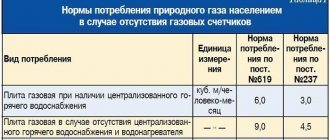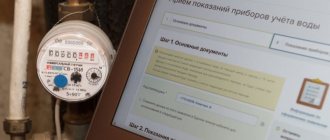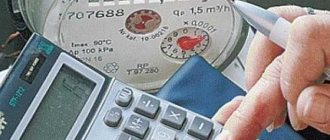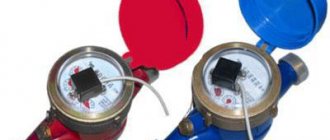Visual differences between hot and cold water meters
The widespread use of IPU (interpretation - individual metering devices) made it possible to establish control over resource consumption, which provided the opportunity for significant savings. Among the basic utilities that are metered, water supply is one of the most important. Depending on the design of the communication system of an apartment or house, the object may be equipped with one or two devices.
Water meters have visual differences that you need to pay attention to when purchasing and installing:
- Data on the box. The IPU of hot water is marked “DHW”, cold water – “HVS”. It is taken into account that the first option is universal and can be installed on any system, while the second is only suitable for a specific use.
- The color of the factory seal (edging) or lines on the body. Hot water meters are red, cold water meters are blue. This distinctive sign allows you to quickly and accurately determine the purpose of the device.
- Maximum temperature of the water passed through. Each mechanism has a list of technical characteristics on its main part, which includes the permitted temperature range. For cold water this is from +5 to +50°C (there are options up to +30 or +40°C), for hot water – up to +90.
There are several types of certified water meters, but all models designed for cold water metering have a blue or blue color, hot water meters are decorated with a red edging
Some modern devices do not have pronounced visual differences, so you should definitely look at the information in the passport.
On a note! It is recommended to pay attention to the date of verification of the meter: it is from this time that the countdown begins until the next performance assessment.
Taking readings
In order to correctly write off readings for submission to a service organization, you need to know exactly what to read.
The counter dial includes 8 digits. The first five black symbols are the main ones; they show the total number of cubic meters of water consumed. This information must be recorded on the payment receipt. The last three red digits are auxiliary, separated from the main ones by a comma and indicate the consumed liters.
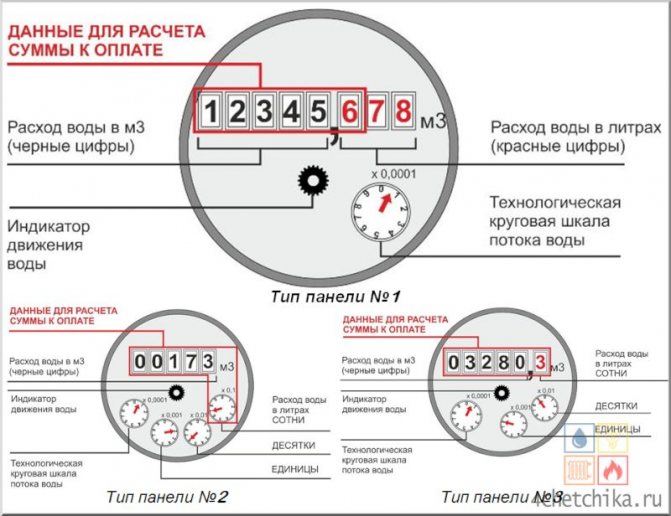
At the moment, water meters are produced with three types of panels, but in the domestic sector, type No. 1 is considered the most popular and easiest to operate.
General rules for taking readings:
- The characters before the comma must be specified first. It is taken into account that when transmitting information there is no need to write off the leading zeros.
- If the last three digits are greater than 600, then it is advisable to round the value to the cube. This is not a violation.
Information from the meter should be taken according to the following scheme:
- The numbers on the dial (for example, 00015.784) indicate that more than 15 m3 of water was consumed during the corresponding period.
- The number of liters is rounded to 16 cubic meters. These readings are transferred for calculation.
- Next month the data will change and the dial will show 00022.184 (22 m3).
You need to understand that it is the current readings that are taken into account. But most often, the owner of the premises does not need to deal with the number of cubic meters; this is done by the service organization.
How to take water meter readings
Red indicates water consumption in liters, you are unlikely to need it, pay attention to the black indicator numbers, they display water consumption in cubic meters, so they are used to take readings and pay.
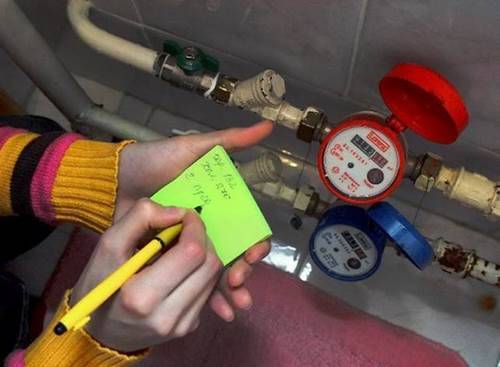
Suppose you installed a new meter and the number of hours in a month is 00013780, this means that in a month you have used 13 cubic meters and 780 liters of water. When accounting and paying, you can, for convenience, round this value to 14 cubic meters and pay your water bill using exactly this amount .
Calculation example
Anyone living in a private house or apartment with water meters can independently calculate the expected payment amount for the billing period.
To do this, the following information is required:
- Indicators of cold water and hot water meters.
- Information from both counters for the past month. If there are no records, the data can be found on the receipt.
- Current tariff. It is individual for each subject of the Russian Federation. You can find out more information on special websites where the cost for the current period is published, or on the payment receipt.
You can calculate the monthly amount as follows:
- Take data from an individual hot water meter (conditionally 00085.456) and a cold water meter (000157.250).
- Prepare readings for the past period: DHW – 00080.255, cold water consumption – 000147.155.
- Find out the tariff for the region. It is taken into account that the cost is allowed to increase every year. Thus, in Moscow, from July 1, 2020, for most areas, one cube of cold water costs 35.40 rubles, hot water – 173.02 rubles.
- Determine the amount of resources consumed per month. To do this, the current values are subtracted from the previous ones (whole cubic meters are taken as a basis). For DHW: 85–80=5 m3, cold water: 157–147=10 m3.
- Calculate the payment amount:
DHW: 5m3 x 173.02=865.1 rub.
Cold water: 10m3 x 35.40=354 rub.
Total for the month: 865.1+354=1219.1 rub.
Water drainage calculations are made based on general data. Some service organizations post an online calculator on their websites; it can be used to calculate any resource provided, but only for informational purposes.
Attention! If the tariff in the payment document does not correspond to the one determined for a specific territory, then you must immediately contact the utility service provider. If your actions are illegal, you can file a complaint with the regulatory authorities.
How to calculate payment for water using a meter in an apartment
- Method one. If you have a prepaid payment system, you will need the meter readings that were indicated last month and the new readings for the date recommended by the utility supplier (for most companies this is the 25th of the month). To calculate the cost of hot water by meter, you will need the current tariff and the difference between the readings. The reading difference module will be your consumption at the metering point (there may be two of them in an apartment). The tariff can be found on the website of the water utility or thermal power plant. Often the rates are indicated on the receipt. By simply multiplying two values, you get the monetary expression of the existing debt for the consumed resource. Now you know how to read water meters. The amount is entered into the receipt and paid using the method chosen by the consumer.
- The second option is more preferable in terms of convenience and compliance with the law. No one is obliged to pay for a resource that has not yet been consumed (as of the 25th). This rule does not apply to legal entities.
All the subscriber needs to do is pay the amount calculated in the receipt based on the readings of the previous month and enter the indicator values in the counterfoil field, which will become the basis for a new calculation by the water utility. A group of subscribers who know how it is in Moscow usually uses the second option of working with the supplier.
If you have meters installed
The first thing to do is determine their serviceability and sealing. Typically, this element is installed by a housing and communal services employee, who also seals each meter. Issues a receipt for service life and next inspection or replacement.
WE STRONGLY DO NOT RECOMMEND INSTALLING THE METER YOURSELF. SERIOUS PROBLEMS WILL ARISE WITH DIFFERENT AUTHORITIES. THIS METER WILL BE ILLEGAL.
If you decide to install meters. Visit your housing and communal services department, find out which model you need to purchase and agree on the day of installation. Everything is done quickly. No hassle, same day or within 1-3 business days.
You have everything installed, the appropriate authority has confirmed its serviceability and registration.
There is an indicator on the outside of the meter that shows how much water has been used; you can see from the roller when the supply occurs (it rotates); if water is not supplied, the indicator stands still. The product model is also indicated.
The standard indicator consists of 8 digits.
- First, 5 black digits are indicators in cubic meters
- The next 3 digits are red - how much water was supplied in liters
The next step is to determine which unit is for which water. Under standard conditions, the hot water pipe runs higher. You can simply touch the pipe and determine where the hot water is and where the cold is.
How to fill out a receipt
At the moment, almost all accruals for consumed resources are carried out automatically. This provides a more convenient calculation procedure and eliminates errors, but does not relieve owners of houses and apartments from the need to check information.
In some situations, you may need to fill out the receipt yourself.

Sample of filling out a receipt
Step-by-step instruction:
- The period of document generation is indicated. All values must be entered legibly, without errors or corrections.
- Personal information is entered into the corresponding line of the table: full name, address, household IPU number, if it has not been registered previously.
- The number of people registered in the apartment or house and the number of persons entitled to receive benefits are indicated.
- If any, the debt or overpayment is included. The name of the service is marked taking into account the unit in which it is measured and the time period.
- The volume of consumption for the billing period is entered.
- Enter the full amount to be paid, after which you need to calculate the total taking into account benefits.
- All information is clarified and confirmed by signature.
- If during the specified period the meter was being calibrated, then consumption will be measured based on the average value for 3 or 6 months.
The completed receipt must be submitted to the institution that provides admission.
How to calculate water drainage using a meter: formula and example
If you don’t trust online calculators or just want to understand how the amount to be paid is formed, then calculate it manually. To calculate water drainage from a meter, you need to use a special formula:
SV = (DHW + cold water) x TV, where
SV – total amount to be paid; DHW – monthly hot water consumption, based on the IPU reading, m3; Cold water consumption - monthly consumption of cold water according to the meter, m3; TV – regional tariff.
This calculation is regulated by the Government Decree “On the procedure and conditions for citizens to pay for housing and utilities.” The regional tariff for each subject of the Russian Federation is individual.
For example, let’s calculate the cost of the service in Moscow. The local regional tariff (TV) is 21.90 rubles/m3. The monthly consumption indicator according to the meter is 10 cubic meters of cold water and 5 cubic meters of hot water. The total consumption of hot and cold water supply is 15 m3.
Substituting known values into the formula, we get:
(5 + 10) x 21.90 = 328.5 rubles.
The owner must repay such an account by the 20th of the next month.
If your sewer payment is late, the city water utility will issue a fine. If repayment of the debt is delayed, the organization will consider that its rights have been violated. Penalties will be accrued daily.
For those who do not want to calculate water drainage by meters themselves, there are specialized portals where you only need to enter the readings. Next, the system will display the amount to be paid.
In case of any controversial situations, you must immediately contact the Management Company for clarification. For example, if after an independent calculation it turns out that the resulting amount is less than that calculated by the city water utility. There have often been cases when employees of the Criminal Code took advantage of the inattention of conscientious citizens and entered increased testimony.
How to pay for water by meters
The procedure for making a payment may vary depending on the region and service company, but most often the standard scheme applies:
- Water meter readings are taken. Information must be submitted at a certain time. The exact period is not specified in the law and is set by housing and communal services enterprises and management companies independently. To avoid mistakes, it is better to clarify the period in the contract with the service provider. Information from the EIRC and other specialized organizations is accepted.
- Based on the data received, the service company makes a calculation and sends a receipt to the owner of the premises.
- Any authorized person can pay for the consumed resource. The easiest option is to give the document to a settlement center or bank.
It is taken into account that it is necessary to transmit water meter readings exclusively to the utility service provider. This role can be played by a homeowners’ association, a management company and supply organizations. Situations are also allowed when the main performer delegates the functions of receiving data to a specialized structure.
Service companies present different ways of taking testimony. The most convenient option is via the Internet or using programs. The traditional method is to enter the data on the form and leave it in a special box or take it directly to the organization’s office.
How to calculate water using a meter? 2020
Transmission of water meter readings is a procedure on the basis of which the consumed resource is calculated. Timely and correct provision of information ensures payment at a single tariff, which eliminates the emergence of disagreements with the management company or resource supply organization.

The widespread use of IPU (interpretation - individual metering devices) made it possible to establish control over resource consumption, which provided the opportunity for significant savings. Among the basic utilities that are metered, water supply is one of the most important. Depending on the design of the communication system of an apartment or house, the object may be equipped with one or two devices.
Water meters have visual differences that you need to pay attention to when purchasing and installing:
- Data on the box. The IPU of hot water is marked “DHW”, cold water – “HVS”. It is taken into account that the first option is universal and can be installed on any system, while the second is only suitable for a specific use.
- The color of the factory seal (edging) or lines on the body. Hot water meters are red, cold water meters are blue. This distinctive sign allows you to quickly and accurately determine the purpose of the device.
- Maximum temperature of the water passed through. Each mechanism has a list of technical characteristics on its main part, which includes the permitted temperature range. For cold water this is from +5 to +50°C (there are options up to +30 or +40°C), for hot water – up to +90.
There are several types of certified water meters, but all models designed for cold water metering have a blue or blue color, hot water meters are decorated with a red edging
Some modern devices do not have pronounced visual differences, so you should definitely look at the information in the passport.
On a note! It is recommended to pay attention to the date of verification of the meter: it is from this time that the countdown begins until the next performance assessment.
In order to correctly write off readings for submission to a service organization, you need to know exactly what to read.
The counter dial includes 8 digits. The first five black symbols are the main ones; they show the total number of cubic meters of water consumed. This information must be recorded on the payment receipt. The last three red digits are auxiliary, separated from the main ones by a comma and indicate the consumed liters.
At the moment, water meters are produced with three types of panels, but in the domestic sector, type No. 1 is considered the most popular and easiest to operate.
General rules for taking readings:
- The characters before the comma must be specified first. It is taken into account that when transmitting information there is no need to write off the leading zeros.
- If the last three digits are greater than 600, then it is advisable to round the value to the cube. This is not a violation.
Information from the meter should be taken according to the following scheme:
- The numbers on the dial (for example, 00015.784) indicate that more than 15 m3 of water was consumed during the corresponding period.
- The number of liters is rounded to 16 cubic meters. These readings are transferred for calculation.
- Next month the data will change and the dial will show 00022.184 (22 m3).
You need to understand that it is the current readings that are taken into account. But most often, the owner of the premises does not need to deal with the number of cubic meters; this is done by the service organization.
Anyone living in a private house or apartment with water meters can independently calculate the expected payment amount for the billing period.
To do this, the following information is required:
- Indicators of cold water and hot water meters.
- Information from both counters for the past month. If there are no records, the data can be found on the receipt.
- Current tariff. It is individual for each subject of the Russian Federation. You can find out more information on special websites where the cost for the current period is published, or on the payment receipt.
You can calculate the monthly amount as follows:
- Take data from an individual hot water meter (conditionally 00085.456) and a cold water meter (000157.250).
- Prepare readings for the past period: DHW – 00080.255, cold water consumption – 000147.155.
- Find out the tariff for the region. It is taken into account that the cost is allowed to increase every year. Thus, in Moscow, from July 1, 2020, for most areas, one cube of cold water costs 35.40 rubles, hot water – 173.02 rubles.
- Determine the amount of resources consumed per month. To do this, the current values are subtracted from the previous ones (whole cubic meters are taken as a basis). For DHW: 85–80=5 m3, cold water: 157–147=10 m3.
- Calculate the payment amount:
Total for the month: 865.1+354=1219.1 rub.
Water drainage calculations are made based on general data. Some service organizations post an online calculator on their websites; it can be used to calculate any resource provided, but only for informational purposes.
Attention! If the tariff in the payment document does not correspond to the one determined for a specific territory, then you must immediately contact the utility service provider. If your actions are illegal, you can file a complaint with the regulatory authorities.
At the moment, almost all accruals for consumed resources are carried out automatically. This provides a more convenient calculation procedure and eliminates errors, but does not relieve owners of houses and apartments from the need to check information.
In some situations, you may need to fill out the receipt yourself.
Sample of filling out a receipt
- The period of document generation is indicated. All values must be entered legibly, without errors or corrections.
- Personal information is entered into the corresponding line of the table: full name, address, household IPU number, if it has not been registered previously.
- The number of people registered in the apartment or house and the number of persons entitled to receive benefits are indicated.
- If any, the debt or overpayment is included. The name of the service is marked taking into account the unit in which it is measured and the time period.
- The volume of consumption for the billing period is entered.
- Enter the full amount to be paid, after which you need to calculate the total taking into account benefits.
- All information is clarified and confirmed by signature.
- If during the specified period the meter was being calibrated, then consumption will be measured based on the average value for 3 or 6 months.
The completed receipt must be submitted to the institution that provides admission.
The procedure for making a payment may vary depending on the region and service company, but most often the standard scheme applies:
- Water meter readings are taken. Information must be submitted at a certain time. The exact period is not specified in the law and is set by housing and communal services enterprises and management companies independently. To avoid mistakes, it is better to clarify the period in the contract with the service provider. Information from the EIRC and other specialized organizations is accepted.
- Based on the data received, the service company makes a calculation and sends a receipt to the owner of the premises.
- Any authorized person can pay for the consumed resource. The easiest option is to give the document to a settlement center or bank.
It is taken into account that it is necessary to transmit water meter readings exclusively to the utility service provider. This role can be played by a homeowners’ association, a management company and supply organizations. Situations are also allowed when the main performer delegates the functions of receiving data to a specialized structure.
Service companies present different ways of taking testimony. The most convenient option is via the Internet or using programs. The traditional method is to enter the data on the form and leave it in a special box or take it directly to the organization’s office.
This is interesting: MFC - how to transfer meter readings 2020
In some situations, it may be necessary to verify the correctness of the enumeration.
Due to incorrect counter information or errors by the receiving employee, excess funds may appear in the account. According to RF PP No. 354, if discrepancies are detected, but provided that the IPU is fully operational and is not classified as out of order, the payment is recalculated.
To return funds, you must:
- Receive from the contractor a copy of the inspection report, which established the presence of surplus due to the difference in readings.
- Write a statement requesting a recalculation of the payment made.
- Submit the documents to a special department of the service company and be sure to receive confirmation that the information has been accepted for consideration.
If everything is done correctly, the due deduction will be indicated on the next receipt. If there is a significant overpayment, the amount is spread over several months.
Advice! If the contractor does not recalculate and does not provide an answer about the decision, you need to contact the regulatory authorities. The cause of failure may be a detected malfunction of the device or damage to control seals, which must be confirmed by an inspection report.
The lack of information about consumed resources recorded by the IPU does not exempt the owner or tenant from paying, since residents are not limited in access to the service and can use water. Based on existing legislation (RF PP No. 354), each owner of a premises that is equipped with a meter has the right to calculate water consumption according to the readings of a correctly installed and commissioned meter. In such a situation, the amount is calculated at a single tariff for a specific region.
If you do not submit meter data, then the payment calculation method changes: for the first 3 months, the average indicator for the past six months is taken as a basis, and then according to the standard. Changing the situation is quite simple: you need to invite a specialist from a service organization to check the meter and take control readings.
In this case, it will not be possible to achieve recalculation, since it was the owner who ignored the right granted to him to submit monthly information.
Exceptions include special cases that may require legal proceedings where it will be necessary to prove the presence of force majeure circumstances or confirm temporary absence.
Of course, installing water meters helps save money. Most residents believe that installing such devices is economically feasible.
But another question arises: how to calculate water using these devices? Detailed answers to this and other related questions are presented in our article.
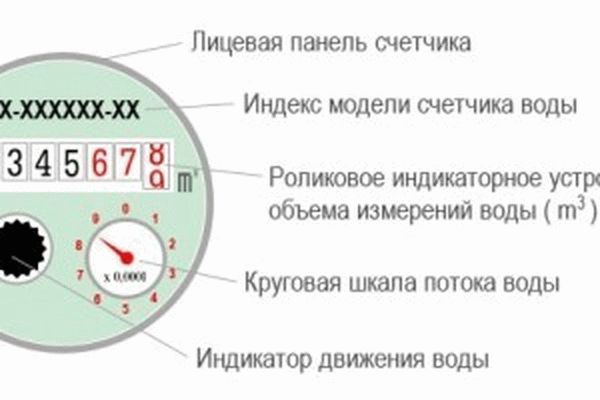
So, meters are installed in the apartment. To calculate the volume of water consumed for a certain period (month), look at the apartment payment receipt for the last month and write off the latest readings from it.
Some management companies now enter this figure directly into the payment document. If this is your first payment after installing water meters, the previous indicator is zeros.
Now let's learn how to take accounting readings. The scale of modern meters gives us 8 digits. The first five of them are black, and the last 3 are red.
Since the corresponding columns of the payment document reflect the number of cubes of either cold or hot water spent, pay attention to the black indicators. These are the ones that need to be written down on the receipt. Indicators of red numbers - liters of water spent by your family are not indicated.
Water meter readings are taken at the end of each billing period (month). Meter data can be transmitted by telephone or via the Internet (in an electronic document) to a specialized organization.

Management companies count water according to meters, based on Decree of the Government of the Russian Federation No. 354, adopted on May 6, 2011 and in force from the fall of 2012 until now.
These legislative Rules, in comparison with the old ones, are fairer, but are still far from perfect.
Payment for water by meters now consists of several components, taking into account:
- The readings of the meter scale located in a certain apartment, installed to calculate the amount of cold resource consumed this month.
- Readings from a meter located in a specific apartment, installed to calculate the amount of hot resource consumed this month.
- Readings from a device installed in your home (in the basement), installed to calculate the amount of cold resource spent by all residents.
- Readings from a device installed in your home (in the basement), installed to calculate the amount of hot resource consumed by all residents.
- A share consisting of your apartment in a house. It is taken into account when determining the amount spent on the needs of the entire house (the so-called “general house needs”).
- The share that corresponds to your apartment in the house. It is also taken into account when determining the hot water spent for the needs of the entire house (the same so-called “general house needs”).
The first two components of the list are the consumed water resource, the volume of which depends only on you and the size of your family’s needs. The remaining items consist of the actual needs of the entire house, for example, wet cleaning of stairs and apartment areas.
And the “lion’s” share of general house expenses is overexpenditure resulting from riser leaks, unscrupulous residents who incorrectly indicate the cubic meters they spent or live in the house, use communications, but are not registered at their place of residence.
This is interesting! How to seal water meters: legal requirements and procedure

It is possible to calculate the costs associated with water consumption by multiplying the volume spent by the corresponding tariff indicators in a particular locality.
According to the volumes of water consumption indicated by you, according to the readings of apartment meters, the cost of payment for the sewerage service, which provides for the removal of wastewater, is also calculated.
To calculate this number, you need to add up the volumes that you took from the meters and multiply by the tariff.
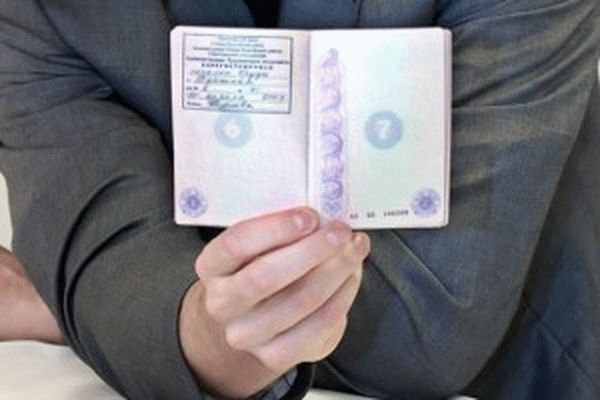
We draw your attention to the article on how to pay utility bills via the Internet.
And in this article you can find out how long you can live without registration.
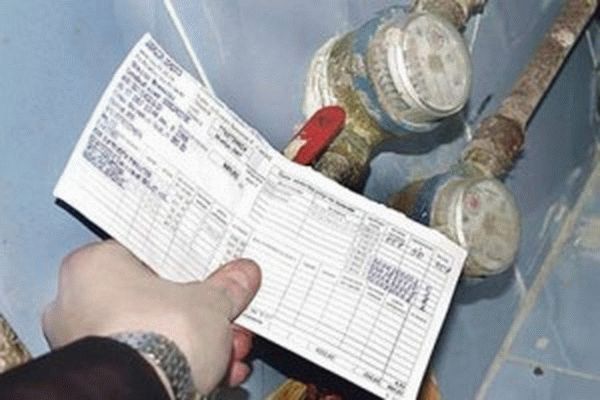
- The amount in cubes of cold water that was spent by consumers over a certain period, if general house water meters are installed in the house, the volume spent by both residents and those who own non-residential premises is taken into account.
- Hot water, which was spent by consumers over a certain period, if the house has communal water meters, taking into account the volume spent by both residents and those who own non-residential premises.
- The amount in cubes of cold water used for utilities such as heating.
- The area of all premises in your house, this means both residential and non-residential apartments.
- The area of the apartment you use in this house.
So, this formula involves calculating the overexpenditure of the resource used in comparison with the calculated standards for your home.
As discussed above, overspending typically includes:
- Possible leakage from riser pipes.
- Use of water by non-registered residents.
- The “cunning” of neighbors who indicate the wrong number of cubes on the payment slip.
In accordance with the Rules specified in the article, the owners of apartments and non-residential premises will pay for overused water, in proportion to the occupied area.
This is interesting: The law on replacing the water meter, is it necessary to change it in 2020
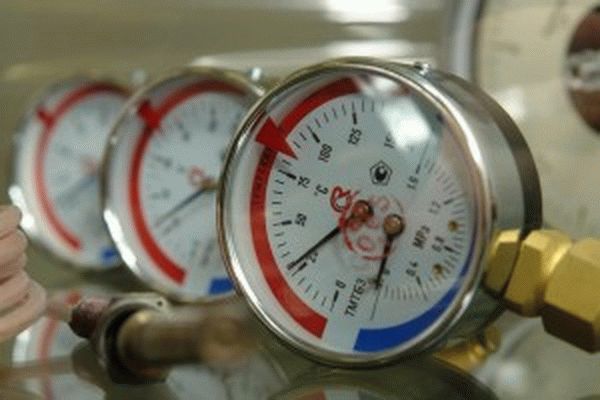
However, our Government took care of citizens burdened with utility bills, and in 2013 established consumption standards for general household needs.
These norms restrain the “appetites” of management companies and are developed independently at the local level. To find out their values, contact your management company in writing.
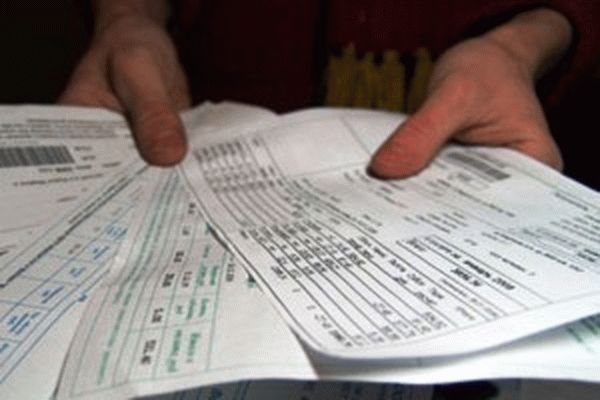
According to paragraph 44 of the Decree of the Government of the Russian Federation of April 16, 2013, the volume of general household needs (CHN) should not exceed the standard consumption established by local authorities.
The management company does not have the opportunity to charge you for payment for the volume of general house consumption that exceeds the established standard.
Again, if the water supply contract is not concluded with a resource supply company, for example, with Vodokanal. If there is an agreement with the latter, ODN will be paid in full. In conclusion, I would like to draw your attention to the fact that in some localities they establish a fixed minimum payment that must be paid, regardless of whether you actually spent it or not.
It is taken into account that in the event of an overpayment in a certain month for what was not actually spent, this overpayment will be offset in the next reporting period. And rightly so.
If you are not a resident of a high-rise building, but own a house in the village, remember that payment is calculated using a similar method, according to the current water supply tariff. Watch a video tutorial on how to take water meter readings correctly:
More and more people are trying to install a water meter in their apartments, believing that this will bring benefits, however, not everyone knows how to calculate hot water using a meter.
The problem of hot water supply is extremely urgent for many Russian cities. It’s worth starting with the fact that in some settlements there is no centralized hot water supply at all. In this case, the issue is resolved by using electric or gas water heaters. Sometimes their use becomes more profitable than receiving already heated water.
Paying for hot water supply is very expensive for those who do not have meters installed, so experts recommend not skimping on installing equipment to accurately count the cubic meters consumed. This allows you to save significant amounts every month and not overpay for water that was not actually used.
Those who have not previously encountered hot water meters and do not know how to calculate hot water using a meter believe that calculating payment is a rather complicated process. In fact, if we are talking about centralized hot water supply, then there are no difficulties: payment by meter for hot water is calculated in the same way as for cold water, but at different tariffs, which are set by the authorities.
Representatives of state and local authorities are responsible for how much the population in a particular region will have to pay for hot water. Tariff calculations are carried out on the basis of Federal legislation.
On a note! Tariffs in different regions of the country and even in different localities can vary greatly, but for all regions there are certain indices above which tariffs for hot water supply cannot be raised.
Moreover, some categories of citizens who are entitled to benefits can take advantage of discounts. In this case, the payment for hot water by the meter will be calculated using a special formula. An example of how to calculate hot water using a meter can be found below.
Many do not fully understand that the tariffs set by the state and local authorities include payment not only for the water itself and the energy spent on heating it: money is also collected for organizing the supply of hot water.
In addition to how to calculate hot water by meter in 2020, you should also know that the hot water tariff also includes:
- payment for energy spent on heating water;
- costs for the purchase of cleaning components;
- costs of purchasing various components for supplying liquid to the consumer;
- the cost of laboratory tests to control water quality;
- employee salaries;
- contributions for major repairs.
Also, do not forget that not a single company will operate at a loss, and therefore the cost of each cubic meter of water includes the net profit of the organization organizing its supply.
All these components are strictly regulated by law, which means that the supplier does not have the right to raise the price of a certain service at his own discretion.
Many consumers, even those who have recently installed hot water meters, can already feel a reduction in financial costs for utility bills from the first month. The main thing when deciding to install a meter is to understand how to calculate the hot water consumption by the meter.
It is worth noting that the change in financial costs for hot water does not depend on the fact that a cubic meter of hot water became cheaper when a meter was installed - in fact, the tariffs remain the same in any case. The only difference is that without metering devices you have to overpay for extra cubic meters, which are fixedly charged for each person registered in an apartment or house. In this situation, it does not matter whether a person lives at his place of registration or how much water he actually uses.
Important! With metering devices everything is much simpler; the main thing is to know how to calculate hot water using a meter.
In this case, you need to pay only for the amount of liquid that was actually consumed. The amount may be several times less than without a meter.
Not every apartment building has communal water meters installed. They are not very convenient, but they also help save on paying for hot water. In this situation, pricing is carried out not by the number of residents in the apartment, but by its area, taking into account personal utility rooms.
The responsible person takes the indicators from the general meter, this figure is multiplied by the tariffs provided for the given locality, and then the total amount is divided among the apartment owners, taking into account the size of the premises. This formula is provided for by Russian legislation in case of using a common meter.
A common house meter cannot be called the most convenient solution, and therefore most Russians try to install hot water meters apartment by apartment. This makes it possible to pay only for the amount of water that was actually used. As for the common meter, it will really only be beneficial for large families who live in small apartments and consume a lot of hot water. For others, the only advantage of this type of metering is that they will not have to pay for hot water supply during periods of its complete absence, for example, during network repairs.
As for how to calculate hot water using a meter, it is worth noting that the hot water meter is quite easy to use. After installing it, the amount of water that will pass through the pipe will begin to be recorded. As a rule, initially a certain value is already “increased” in the counter, since this is necessary to check the device. This number is entered into the payment receipt in the form of initial readings. The initial value of the meter readings must also be recorded by those who will put a seal on the device.
This is interesting: How to register an electricity meter: list of documents 2020

Not so long ago, apartment meters for hot and cold water began to come into use. These simple devices are designed to protect consumers from inflated bills for water consumption. Flow meters show the values of wasted water in cubes. Using these data, it is not difficult to calculate the amount of payment per month, but you need to know which numbers are responsible for what.
Now, probably, there is not a single apartment building that does not have at least common building flow meters for hot and cold water. And in some new buildings, water meters are installed directly in the apartments. To begin with, it is important to understand the fundamental difference between common house appliances and apartment appliances.
General house meters take into account the water consumption of the entire house, including non-residential premises (shops, hairdressers, etc.) and expenses for wet cleaning of entrances. In-apartment meters show the volume of water spent in each apartment. Both are painted in corresponding colors: red for hot water and blue for cold.
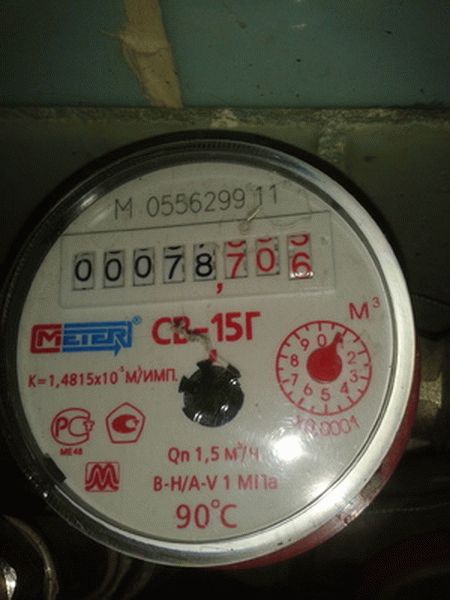
A seal is installed on each device by an employee of the management organization. He also records the first readings, usually 8 zeros. This first data will be necessary in order to be able to easily read water from the meter in the future.
On the front side of the device there are 8 windows with numbers: first black, then red. Since one cubic meter of water contains 1 thousand liters, then, by analogy with electricity meters, the black numbers are cubes, and the last three (as after the decimal point) are liters. The main settlements with regulatory organizations are carried out in cubes.
To transfer the readings to the management organization, the consumer is provided with a payment receipt form. The following columns are filled in: readings at the beginning of the billing period and final data in the form of 5 digits. Some samples also have a “Difference” line and a written tariff, so you can immediately calculate the cost.
It is not necessary to bring payment receipts to the management company. Testimony can be transmitted in several other ways:
- by telephone to the housing and communal services call center operator;
- SMS to a short number assigned to the management company;
- via the Internet, using online services of banks and other payment systems.
This example does not take into account expenses for general household needs. The management company lists them as a separate line on the receipt. They represent a fixed amount or are calculated based on the difference in the information submitted and the readings of common house meters.
When water meters first appeared, many were afraid of the cost of the devices themselves , but installed flow meters significantly reduce the payment for consumed resources. The payment according to the standard, which is approximately 6 cubic meters of cold and 3 hot cubic meters per month and does not change depending on the time of year, turns out to be significantly higher if the family spends the entire summer at the dacha and the apartment is empty.
In addition, there are a number of tricks that will help reduce costs even more:

Eliminate all leaks from the system in the apartment. It’s very simple to check if they are there: close all the taps tightly and watch the meters for a while. If the relay does not turn, then there are no leaks.- Submit instrument readings in a timely manner. It is best to do this on the same day, for example a day or two before the end of the billing period.
- If you are away from the apartment for a long time, you should make sure that the meter readings are transferred to the management company. Now this can be done through online services and even via SMS.
If there are no leaks, but suspicions of excessive water consumption remain, then it is worth checking the correct operation of the device itself. To do this you will need a 10-15 liter bucket. The procedure is as follows:
- make sure that all taps in the house are closed;
- write down or remember the readings on the meter in liters (last three red digits);
- collect 2-3 buckets, pour into the sewer;
- compare instrument readings.
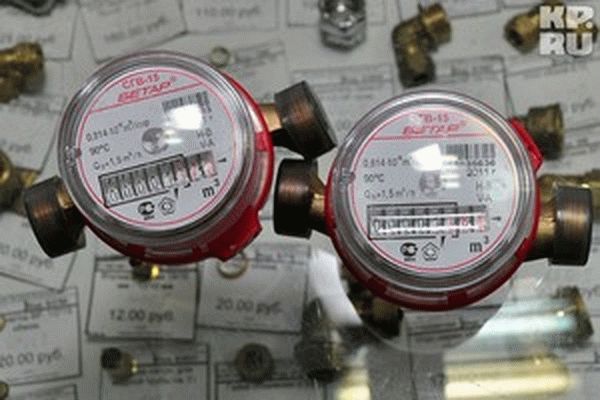
Depending on the volume of the container, the meter should show from 20 to 45 liters. If the readings differ to a large extent, it is necessary to call a specialist to carry out a verification, the results of which will reveal the need to repair or replace the metering device.
To install a new meter, you will need the services of a plumber. The company that produced the device must have a license, and the water meter itself must have a technical passport. Only after the device is sealed by a specialist and registered can it be considered ready for use.

It is not difficult to calculate from the meter how much to pay for water, and with the expansion of mobile and Internet services, the question of where to pay for housing and communal services becomes completely irrelevant. Particular care is required when paying via the Internet or telephone, when the testimony and details of the organization are entered into the appropriate fields.
Third-party systems may charge a commission from 0.8 to 5% depending on the size of the payment and the rules of the service, or a set minimum amount. You can pay for the calculated cubes of water using Sberbank Online or setting it up in your personal account. The financial institution has set a commission of 1% (or at least 10 rubles).
In addition to online services and mobile applications that almost all banks have, payments can be made through specialized systems such as “System City”. Some telecom operators, for example Beeline and MTS, also offer the transfer of funds from the client to the supplier. But only those who own a SIM card from the corresponding mobile operator can count on connecting to this service. In addition, the list of management companies that can be settled in this way is very limited.
Pay for hot and cold water supply services without commission through PayQR. QR codes have appeared recently, so not all management companies have them printed on receipts, but no commission (provided that the homeowner uses the appropriate application) will be charged.
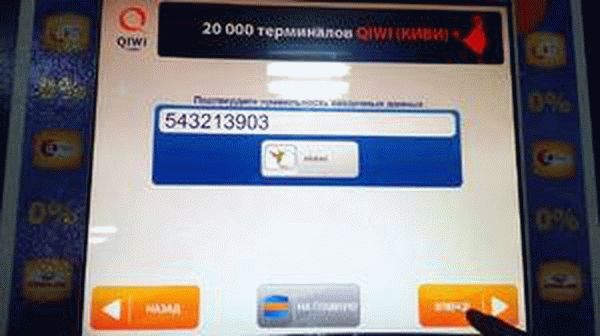
Another option is to transfer fees using the government services portal. The portal itself is not a payment system, but only acts as a third party between the client and the management company, therefore it warns that a certain contribution may be withheld by the financial institution. As a rule, payment through the bank with which the management company has an agreement is made without additional fees.
Each client is obliged to pay regularly and in full for water according to the meter. Which option to choose and where to pay depends on personal preferences. Late or incomplete payment may result in the management organization going to court with subsequent collection of the debt, as well as penalties.
»
Counters
Gas meter with thermal corrector: features of choosing a meter in 2020
Read more
Counters
Two-tariff meter: profitable or not? 2020
Read more
Counters
Until what date should water meter readings be reported in 2020?
Read more
Counters
How to check an electric meter for correct readings 2020
Read more
Great article 0
Recalculation of utility bills
In some situations, it may be necessary to verify the correctness of the enumeration.
If you overpay
Due to incorrect counter information or errors by the receiving employee, excess funds may appear in the account. According to RF PP No. 354, if discrepancies are detected, but provided that the IPU is fully operational and is not classified as out of order, the payment is recalculated.
To return funds, you must:
- Receive from the contractor a copy of the inspection report, which established the presence of surplus due to the difference in readings.
- Write a statement requesting a recalculation of the payment made.
- Submit the documents to a special department of the service company and be sure to receive confirmation that the information has been accepted for consideration.
If everything is done correctly, the due deduction will be indicated on the next receipt. If there is a significant overpayment, the amount is spread over several months.
Advice! If the contractor does not recalculate and does not provide an answer about the decision, you need to contact the regulatory authorities. The cause of failure may be a detected malfunction of the device or damage to control seals, which must be confirmed by an inspection report.
If testimony has not been submitted for a long time
The lack of information about consumed resources recorded by the IPU does not exempt the owner or tenant from paying, since residents are not limited in access to the service and can use water. Based on existing legislation (RF PP No. 354), each owner of a premises that is equipped with a meter has the right to calculate water consumption according to the readings of a correctly installed and commissioned meter. In such a situation, the amount is calculated at a single tariff for a specific region.
If you do not submit meter data, then the payment calculation method changes: for the first 3 months, the average indicator for the past six months is taken as a basis, and then according to the standard. Changing the situation is quite simple: you need to invite a specialist from a service organization to check the meter and take control readings.
In this case, it will not be possible to achieve recalculation, since it was the owner who ignored the right granted to him to submit monthly information.
Exceptions include special cases that may require legal proceedings where it will be necessary to prove the presence of force majeure circumstances or confirm temporary absence.

